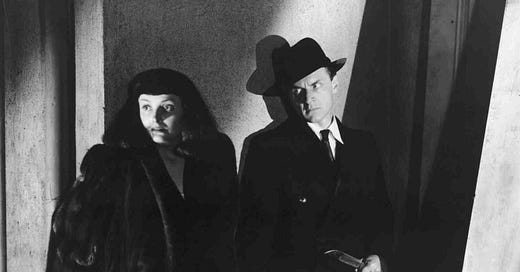In the 1940s, producer Val Lewton was tasked by RKO Studios to produce a line of inexpensive horror movies to compete against Universal Studios re-launched line of classic monsters. Rather than copy the Universal formula, Lewton chose to make stylish and low key movies that delivered slow burn chills.
The Seventh Victim is not the best of his efforts, which is not a major criticism; all of the Lewton horror movies range from solid to masterful. What The Seventh Victim provides is a confused narrative rescued by superb mood and atmosphere.
(spoilers) Mary Gibson is called away from her private boarding school when her sister Jacqueline goes missing. Mary travels to New York to track her down; in short order she discovers Jacqueline sold her business to a subordinate and rented a room above an Italian restaurant but never moved in. When the room is opened it is empty except for a chair and a noose hanging from the ceiling.
She finds Jacqueline's lawyer, who later turns out to be married to her and her psychiatrist, Dr. Louis Judd. From them, she learns that Jacqueline was a member of a Satanist group and that she has been suffering from depression and suicidal thoughts. She hires a low rent private investigator, who helps track Jacqueline to a locked room at her old cosmetics factory. In a terrifically suspenseful sequence the P.I. vanishes into complete darkness at the end of a corridor then re-emerges clutching his stomach with a stab wound.
From there, Mary is briefly re-united with Jacqueline, discovering that she was the one who killed the P.I. in a moment of panic. Jacqueline vanishes again, kidnapped by the cult, who try and force her to drink poison for revealing their existence to outsiders.
As I said, the plot of this movie is a bit of a mess. Multiple characters are involved in the hunt for Jacqueline and they kind of stumble over each other as Jacqueline appears and disappears. Jacqueline's husband hides his marriage from Mary for no reason, then falls in love with her inexplicably. A failed poet is inserted into the story. Dr. Judd, played by Tom Conway, is the same character from Cat People, and he speaks of a woman patient who went insane, but his character died in that movie.
But in the last third of the movie, the cinematography shifts and the movie is deeply immersed in darkness and shadows, never to re-emerge. Gone are the day lit scenes of the early half. One sequence is set in the headquarters apartment of the Satanists, where they surround Jacqueline, leaning down out of the darkness, urging her to take her own life. Another masterful sequence follows Jacqueline as she flees down an alley after escaping, pursued by a sinister figure who moves in and out of the shadows.
Nicholas Musuraca was the director of photography for The Seventh Victim as well as other Lewton classics like Cat People, Curse of the Cat People, and Bedlam. He also worked on the Noir classic Out of the Past and what some claim is the very first Noir: Stranger on the Third Floor.
Musuraca was highly influential: not only did he establish the moody aesthetic of the Lewton horror films, he set the tone for much of RKO's output of the 1940s. Some have credited him with establishing the Noir style overall. He brought expressionistic shadow play into movies other than horror or Noir, winning an Oscar in 1948 for the sentimental I Remember Mama.
As the movie moves towards it's climax, the omnipresent shadows and darkness combine with the bleak failures of the characters to create an atmosphere of weary resignation, which crescendos with one of the bleakest endings in classic Hollywood history.
Jacqueline, free from the clutches of the cult, but despairing, returns to her apartment. There, she meets her neighbor Mimi, who is dying of a terminal illness. They converse briefly; Jacqueline speaks of the inevitability of death, but Mimi rallies to commit to taking one last night on the town, to live just once more before the end. Jacqueline opens the door of her apartment, where the noose is framed in the doorway.
In the final scene, Mimi emerges from her apartment, dressed to the nines, smiling, heading out to her night on the town. As she passes Jacqueline's apartment, the sound of a chair falling is heard, signaling her suicide.
In a movie that features characters who try gamely to press ahead against destiny, only to fail, that nihilistic ending is brutal. Mary and Jacqueline's husband confess their love for each other but acknowledge it must never be. The poet hands his last chance manuscript to the doctor to give to his publisher, but Dr. Judd scoffs at his attempt as too little too late. Jacqueline's lesbian lover is left bereft of the only woman she ever loved. Even the Satanic coven itself seems sad and pathetic at the end.
The devil never makes an appearance in The Seventh Victim, but I think he would approve of the nihilistic lesson it teaches.





